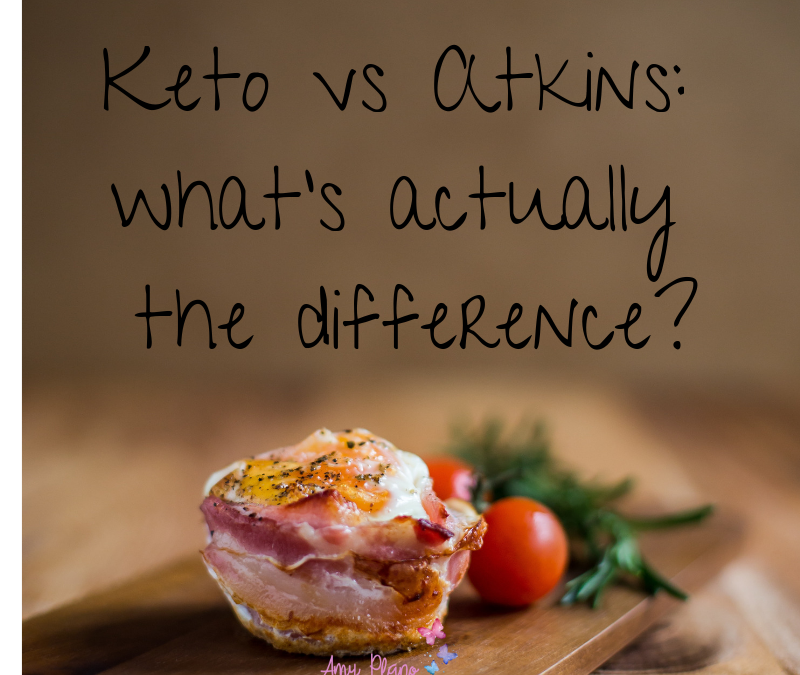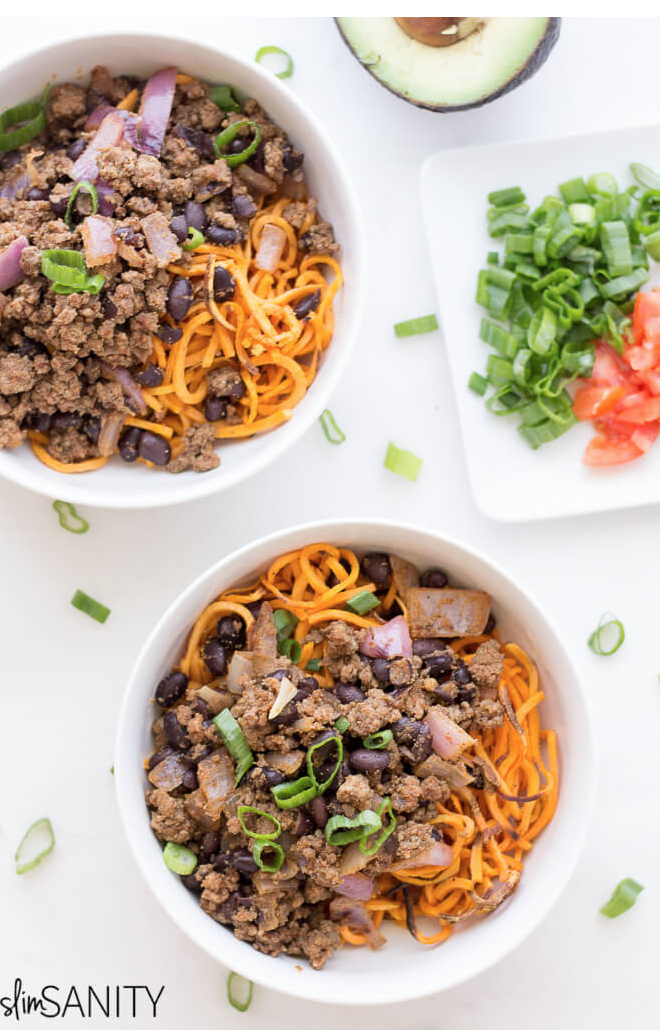
Keto vs Atkins: what’s actually the difference?
Keto vs Atkins: what’s actually the difference?
Keto is such a hot topic these days but is it the same thing as Atkins? Both are low carb, high in fat and share a large majority of the same principles but there are differences. We are going to get to the bottom of this mystery once and for all.
The Great Debate: Carbohydrates Versus Fat
Few things in the world of nutrition are debated as much as “carbohydrates vs fat.” For decades we’ve been told fat is detrimental to our health. Meanwhile low-fat “diet” products, often full of sugar (and crap!) flood just about every aisle in the supermarket. Meanwhile, our population is fatter, sicker and on more medications than ever.

To eat carbs or not to eat carbs. That is the age-old question.
Therefore, it is no surprise that over the last few decades, low carbohydrate diets have made a resurgence. Also thankfully the pendulum has finally swung in a promising direction as it relates to fat intake. Many health professionals now support that a low carb diet is a viable option to treat obesity and other chronic, Western diseases.
Yay finally for legit science!
However, despite advances in research, there still seems to be confusion among the various low carb diets. In fact, one of the common statements I hear in my practice from patients is that they are following a ketogenic diet. But are they really?
More often that not – upon a quick review of their actual eating patterns it becomes apparent their eating style is more consistent with an Atkins diet rather than of a strict ketogenic diet. But does it really matter? Aren’t all low carb diets created equal and illicit the same results? The answer as you will see is not that simple.
Where do I Come in With All of This ?
It is important to note the goal of this blog is purely informational. As a practitioner I have no personal bias as it relates to a low carbohydrate diet. I am neither for or against them. I meet my patients in their health journey ‘where they are’.
With that being said, it is important that my patients are properly educated and not misinformed. Therefore, the intention of this blog is not to debate whether or not a low carb diet is healthy. The intention is to instead to address the differences and similarities of two of the most popular low carbohydrate diets: The Atkins Diet and the Ketogenic diet (aka just Keto). Both are low carb and share a large majority of principles and beneficial outcomes, but a few subtle differences exist too. But what are the main difference between these two diets? And do these differences really matter? Does one promote more long term health benefits? Let’s get some answers.
Similarities Between Atkins & Keto
Before we examine what makes both diets unique it is critical to address the similarities between Keto and Atkins. I believe it these striking similarities that often have someone thinking they are following one type of low carb diet; when in fact they are following a different approach.
Both are Low Carb Diets
At the most basic levels, both Atkins and Keto are low carb diets. However, surprisingly there is no standard definition of what actually constitutes the term “low carb”. Both Keto and Atkins respectively present and adhere to their own definitions. As you will see, it is these very definitions that set Keto and Atkins apart from one another.
Both are Built on the Premise of Ketosis
Definitions aside, it is fair to make the general assumption that a low carb diet restricts carbohydrates, such as those found in sugary foods, pasta, fruit and bread. For both diets, their success centers around lowering the body’s carbohydrate intake in an effort to lower insulin and consequently burn fat as fuel. This process is known as ketosis.
In the absence of carbohydrates the body produces ketones. Ketones are an alternative fuel source for the body to use when blood sugar (glucose) is in short supply. The goal of both Keto and Atkins is to tap into the body’s fat burning potential. Once this switch is flipped, the body changes from burning carbohydrates to fat.

Therefore, by restricting carbohydrates, insulin levels decrease, and fat burning increases dramatically. As we will see in this blog, ketosis plays a pivotal role in each of the diets but in different ways, thus affecting how sustainable each diet is in the long run.
Both Diets Place an Emphasis on Dietary Fat
High fats foods such a meat, eggs, full fat dairy and liberal amounts of fats form the backbone of both Atkins and Keto. However, Keto greatly favors calories come from fat. While on Atkins, fat receives less of an emphasis, with a more dramatic shift towards higher protein lower carb consumption.
Both Diets Provide Similar Health Benefits
Weight loss is the primary end goal of Atkins. While Keto was developed in the 1920’s as a treatment option for epilepsy. But recent research suggests the Keto and Atkins diets may provide health benefits including by not limited to weight loss, optimized blood sugar, improved insulin sensitivity, even reduced risks of various cancers and some neurodegenerative diseases (1, 2).
The Keto Diet
Keto by definition is a high fat, moderate protein, very low carbohydrate diet. The dietary approach is linear from start to “finish”. There is no maintenance plan once you reach your goal. Instead, you sustain the same fixed eating patterns indefinitely.
The Specifics of a Ketogenic Diet
♥ 5 – 10% of energy from carbs
♥ 20 – 30% of energy from proteins
♥ 65 – 80% of energy from fats
The primary goal of eating in tune with these specific percentages is to get the body in ketosis. By following this high fat, moderate protein, low carb diet the individual is able to significantly lower their insulin levels. This radical shift in fuels prompts the body from burning from glucose to creating and using ketones. In turn, facilitating fat burning.

Keto is a high fat, moderate protein,low carb diet.
Let’s be clear about something. Keto is a high fat diet. Not a high protein diet. So you don’t need/want huge amounts of protein. Protein in excess of what your body uses/needs can be converted to glucose, making it more challenging to get in (and stay!) in ketosis. Most people who think they are following Keto often fail to recognize this piece. They get confused with Atkins where protein intake is unregulated and encouraged. They think the same applies for Keto. Well, it does not. On Keto, protein intake needs to be determined and adhered to in order to maximize results.
Long Term Compliance on Keto
When following a true Keto diet, long term compliance with these specific guidelines is critical. If the guidelines are violated, the benefits of ketosis will not be actualized and the individual may actually end up gaining weight.
Therefore, in embarking on Keto the individual must make (and sustain!) significant, permanent, lifestyle changes. No compromising. No backing away. Just a full lifestyle adjustment regarding how you view food and nutrition. No biggie, right ?
Why You Need to Know your Baseline Calorie Needs on Keto
I know counting calories is often noted as not necessary on Keto. However, I am going to disagree here. Think about it. Keto relies on very specific percentages based on total calories consumed. While I agree due metabolic adaptations in relation to hormone regulation you can likely consume a higher level of calories – you still need a starting point for calories. If you do not establish a baseline level of calories, it is impossible to determine the actual percentages of fat, protein and carbohydrates you need to consume. Therefore, you need a starting point for calories to base your percentages off of. Makes sense, right?
The Atkins Diet
Now let’s transition to the Atkins diet and what makes it is this approach unique.
The Specifics of the Atkins Diet
The are four phases in the Atkins diet: Induction, Balancing, Fine-Tuning and Maintenance. The first phase is the most restrictive and vaguely resembles the overall platforms of a ketogenic diet with one major caveat; there is no restriction on protein just carbohydrates. As time progresses and the individual gets closer to their goal weight complex carbohydrate intake increases and the diet becomes less carbohydrate restrictive.
The 4 Phases of Atkins
Induction: Carbohydrates are restricted to no more than 20 grams per day. Emphasis is placed on high fat and high protein foods, with the source of carbohydrates coming from dark, leafy greens.
Balancing: Nuts are incorporated, low carbohydrate vegetables and small amounts of fruit.
Fine-tuning: As someone approaches their goal weight, they begin to add more carbohydrates slowing down weight loss.
Maintenance: High fiber carbohydrates are significantly increased and based on an individual’s level of “tolerance” more or less or added.
The Basics of Atkins
Fat: No defined amount although liberal consumption of high fat foods are encouraged
Protein: Also no defined amount although liberal consumption of high protein foods are encouraged
Carbohydrates: < 20 net grams of carbohydrates per day during Induction phase with increasing amount through the 4 phases
There are no restrictions on fat consumption. More importantly, there is no restriction on protein. You are encouraged to eat as much protein and fat as long as you keep your carbohydrates where they need to be in each respective phase. You don’t need to ‘hit’ specific percentages for your macronutrients. Additionally, you can eat as many calories as you like. Therefore, depending upon your personal eating style this can become a high calorie, high fat, high protein, low carbohydrate diet.
How Keto and Atkins are Different
So we have addressed both the similarities and the respective differences of Keto and Atkins. Now let’s talk about how they compare. Here is a summary of the keys points.

Differing Factor |
Atkins |
Keto |
Carbohydrate Levels |
Changes from phase to phase, starting with drastic reductions followed by gradual reintroduction. |
Relatively Fixed level: Approximately 5-10% of total calories. |
Carbohydrate Monitoring Method |
Net carbohydrates |
Total carbohydrates |
Protein Intake |
No limit |
Often based pm approximately 1-1.5 grams of protein for each kg of bodyweight. |
Fat Intake |
No set amount – high fat foods encouraged |
High fat intake. As much as 65 – 85% total calories. |
Progression |
4 phase process where carbs are slashed then gradually reintroduced. |
Once nutritional ketosis is achieved optimal carb, fat and protein levels remain unchanged. |
Ketone Production |
Ketosis highest during phase 1. After that ketosis is decreased as carbs are slowly reintroduced. |
Optimal production levels maintained throughout course of diet. |
Time When Individual Achieves Ketosis |
With ketosis the Atkins diet looks to achieve it in phase 1. |
Depends on the individual. |
Distribution of Macronutrients
Perhaps the most significant difference between Keto and Atkins is how the macronutrients are specifically distributed. Macronutrients (aka ‘Macros’) are the amount of carbohydrates, fat and protein someone should consume based on their specific needs. Keto as you have seen is highly specific with finite macronutrient ratios. While Atkins promotes a level of food quality (high fat, high protein, low carb) but makes no mention of actual quantity.
Carbohydrates
There is no denying the fact both diets are low in carbohydrates. However, long term Keto promotes a consistent lower carbohydrate diet. Generally speaking, most people on Keto keep their carbs below 30 – 50 grams for.ever. Yes, as already noted, there are no phases or progression of carbohydrates for Keto. Just one steadfast, unwavering level of uniform carbohydrate intake.
In the Induction phase, carbs on Atkins are set at 20 grams or under. However, as the individual progresses through the various phases additional carbohydrates are added. While these additional carbohydrates are not ‘junk’ carbs – the body still recognizes them with a similar blood sugar response. Additional carbohydrates promote an increase in blood sugar. This rise in blood sugar drives up insulin. Ultimately, knocking the individual out of ketosis.
Which raises the question: “Is Atkins a ketogenic diet?” The answer would be: “No.”
Atkins unfortunately diet does not turn you into a fat burner for the long haul. This is simply because as you progress you are allowed to eat an upward of 100 grams of carbs per day. This amount (for many) is sufficient for your body to keep burning sugar for fuel – not fat. Keto, on the other hand, requires sticking to 30 – 50 grams of carbs per day increasing the likelihood of long term ketosis.
Are All Carbs Created Equal?
One area of carb counting that can get a little confusing is the whole “net” carbohydrate situation. Atkins utilizes a net approach to counting carbohydrates. While Keto counts total carbohydrates. Don’t worry, though — it’s not nearly as confusing as it sounds.
Net carbohydrates are what you’re left with after subtracting the grams of fiber per serving from the total carbohydrate amount per serving. In this approach, you can also subtract sugar alcohols as well such as xylitol, sorbitol and erythritol.
For example, if an item has 30 grams of carbohydrates and it contains 10 grams of fiber, then the amount of net carbs the item contains is 20 grams.
According the creators of Atkins, the method to the madness is the net carb amount reflects the grams of carbohydrate that significantly impact blood sugar level. This follows the assumption there is little to no impact of both fiber and sugar alcohols on blood sugar. Therefore, when following Atkins these are are the only carbs you need to count. Foods that are low in net carbs such as nutrient-dense vegetables and low glycemic fruits such as berries don’t cause a significant impact on blood sugar and therefore are less likely to interfere with weight loss.
Matter of perspective
When it comes to counting carbs on Keto it really depends who you ask! Some true devotees of Keto will count total carbohydrates independent of fiber. While others followers of Keto aim for 20-25 grams of net carbs OR ~ 50 grams of total carbs. Either way you slice it the goal is to keep carbohydrates low enough to decrease insulin levels and facilitate fat burning.
Fat
The Dietary Guidelines set forth by the U.S. government promote a diet containing 20-35 % of total calories coming from fat. Therefore, comparatively Keto is considered a very high fat diet with 65 – 85 % total calories coming from fat. Atkins is also higher in fat than your typical recommended diet. But not as high as Keto. The emphasis is slightly different with Atkins. The focus to is instead on removing carbs while equally boosting protein and fats.
Also unlike Keto, there is no set amount of daily fat you are required to consume on Atkins. The main emphasis on Atkins is to keep carbohydrates below the set level for each phase. While high fat foods are encouraged, fat intake can vary from person to person.
Protein
On Keto an ‘adequate’ or ‘moderate’ amount of protein is encouraged. While on Atkins protein intake (like fat intake) has no set amount. Therefore, it is possible for Atkins to become a low carbohydrate, high protein, high fat diet. Why does this matter?
Certain factors like eating too much protein can (for some individuals) get in the way of ketosis and increase the need for gluconeogenesis. Gluconeogenesis is just a fancy term for making glucose from non-glucose sources like protein and fat. It’s a process when your body converts excess protein or dietary fat you eat into blood sugar for energy. Some researchers believe the protein sources commonly consumed on a low carb diet have the propensity to raise insulin levels. In response to an increase in insulin levels, ketogenesis is down regulated.
This is why eating ‘too’ much protein can impair some individual’s ability to get in and stay in ketosis. But, this does not mean you should restrict your protein consumption either! But what it does mean is someone following Keto NEEDs to determine their adequate level of protein intake. A good general rule of thumb is to aim for 1.0 – 1.5 grams of protein per kg body (3). To convert your weight into kg simply multiply your weight in pounds by 0.45.

By taking the time to determine what a moderate level of protein intake looks like, the individual on Keto can both optimize their fat burning potential and prevent lean muscle breakdown. However, your protein needs are dependent on your activity level, weight, height, gender, body composition, stress and inflammation levels in your body, etc. So keep in mind this calculation is a very basic way to determine adequate protein intake. If you are a competitive athlete you will likely need to adjust this value.
Comparative Summary
In summary, it is fair to say when it comes to Keto and Atkins, Keto is much more specific with very finite guidelines. While Atkins can be seen as more ‘loosey-goosey.’ In order to achieve the benefits of Keto you have to be very precise. While the Atkins diet is more flexible. Hence Atkins could be seen as less intimidating prompting more people to try their hand at this approach. With that being said, some people thrive on a rule-based approach. They need profound structure because otherwise they’re going try to break/bend the rules at any occasion they see fit. So, it really comes down to the individual.
Which One is Better?
In all honesty, despite their similarities and differences I really don’t know which one is ‘better’ per say. My personal stance is “Different strokes, for different folks.” My goal is to meet my patients where they are and guide them based on the scientific evidence that exists. I personally think an argument could be made for pretty much any dietary approach out there. SO I guess it really lies in someone’s goals, level of dedication, persona and long term personal outlook on health and wellness.
Some people just can’t wrap their arms around a low carb, high fat diet. It is SO foreign to them. While others, embrace this dietary approach with unwavering optimism. I think the big thing with either diet is knowing the score. Based on my knowledge, the intention of Keto is more of a true lifestyle change. While Atkins seems for most to be a fairly short-term guide to weight loss. So if you are as they say, ”In it to win it,” I would recommend you go ‘all in’ with Keto and do it right.

But truth be told – I have never.ever.ever. met anyone to be consistent long-term with either approach. Inevitably for most — pizza happens 🙂 But maybe that is just the circle of patients, friends and family members I run with?
Well, I guess that is not true. Research supports long term compliance (> 12 months) on a very low carb diet in the general population is fairly low (4, 5). Surprised? I didn’t think so. Does that mean this approach is wrong? No. It just means a very low carbohydrate diet is very hard to sustain.
My Personal Experience is All I Have GOT!
Also I can only speak from my personal clinical experience. But once people go back to eating normal- carbs and all – they seem to gain weight back with interest. That is because each gram of carbohydrates pulls into 3-6 grams of water into the body. When you significantly decrease your intake of the carbohydrates – you simply take on less water. Increasing protein intake can also have a diuretic effect on the body. Therefore, it is not a surprising when a person goes off a low carb diet – they often experience shifts in fluids and therefore fluctuations in weight.
So I guess the next question becomes can we get the benefits of a ketogenic diet without being going gangbusters with Keto or Atkins? The answer is YES. If there is any uniform message here the key to success is managing insulin. And ‘Hello!” there are numerous ways to that! Last we I talked your ear off about Intermittent Fasting. But you don’t have to go Keto or even engage in Intermittent Fasting if that is not your bag. In fact, the number one insulin sensitizer is exercise!!! Plus, exercise has a host of other extremely beneficial side effects beyond just lowering and managing insulin. So why not start with the lowest hanging fruit? No need to complicate matters anymore than they already are 🙂
One more thing
And one more thing. What gets measured gets managed. Really want to knock it out of the ball park? Start tracking every morsel that goes in your mouth. And I do mean everything! Because before you even begin thinking about changing your dietary approach you need to understand the current status of your diet. The only way to do that is track what you eat and review the data. Plain and simple.
Need help getting started? Why not enlist the help of one of fabulous Plano Program’s Registered Dietitians? They can not only help you determine the most effective food tracking platform – but they can provide an overall assessment of both the quality and quantity (Hello macros!) of your diet. The best part? They are likely covered by your health insurance. So why not take advantage of the awesome opportunity to have someone help you determine what to eat? Make an appointment now by clicking here.
Phew. That was a mouthful! I hope you found the information helpful. If anything I hope it empowers you to select the most appropriate dietary approach when it comes to low carbohydrate diets.
Hugs & High Fives,
Amy
P.S. What have been your personal experiences with low carb diets? Do you find one type of low carb diet was easier to sustain than the other? After reading this were you following one type of low carb diet – when you really were following another type? Please share your experience in the comments below.
References
- Halton TL, Willett WC, Liu S, et al. “Low-carbohydrate-diet score and the risk of coronary heart disease in women.” N Engl J Med. 2006;355:1991-2002.
- Halton TL, Liu S, Manson JE, Hu FB. “Low-carbohydrate-diet score and risk of type 2 diabetes in women. “ Am J Clin Nutr. 2008;87:339-46.
- American College of Sports Medicine position stand. “Nutrition and athletic performance. American Dietetic Association., Dietitians of Canada.,” American College of Sports Medicine., Rodriguez NR, Di Marco NM, Langley S.Med Sci Sports Exerc. 2009 Mar; 41(3):709-31.
- Hu T., Yao L., Reynolds K., Niu T., Li S., Whelton P. K., He J., Steffen L. M., and Bazzano L. A. (2016) Adherence to low‐carbohydrate and low‐fat diets in relation to weight loss and cardiovascular risk factors. Obesity Science & Practice, 2: 24–31.
- Grant D Brinkworth, Manny Noakes, Jonathan D Buckley, Jennifer B Keogh, Peter M Clifton; Long-term effects of a very-low-carbohydrate weight loss diet compared with an isocaloric low-fat diet after 12 mo, The American Journal of Clinical Nutrition, Volume 90, Issue 1, 1 July 2009, 23–32.





